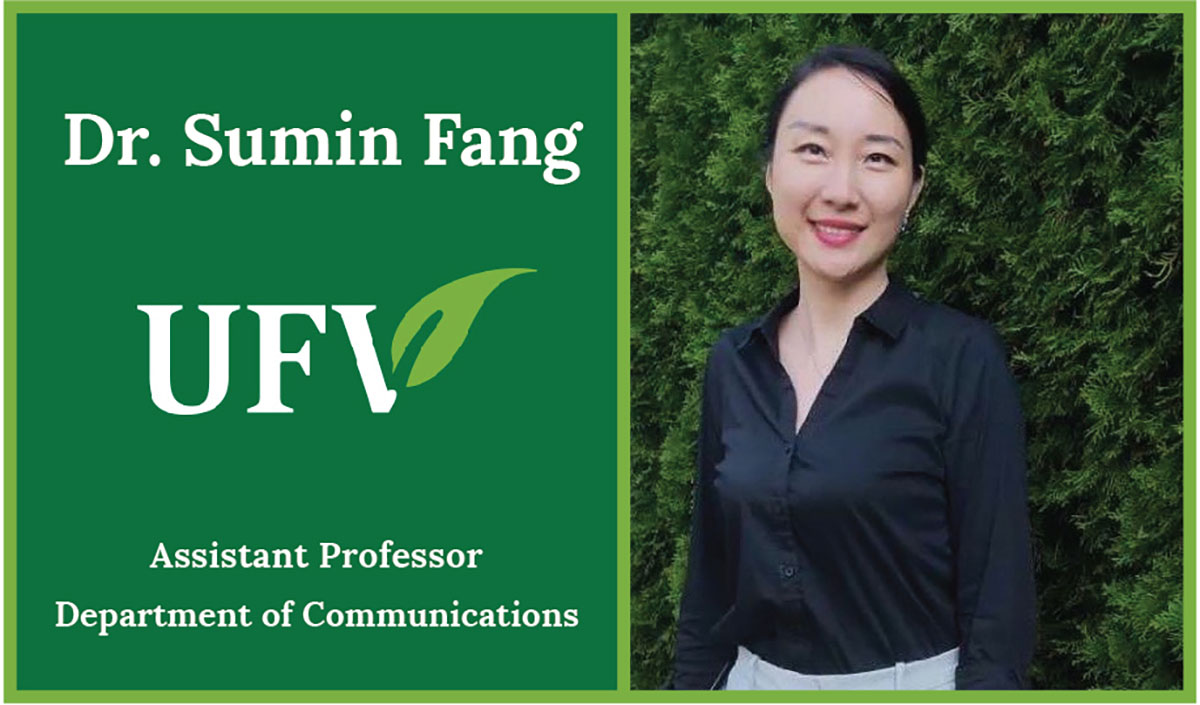Dr. Sumin Fang is an assistant professor in the department of communications and has written about new technology, public engagement, and social media. She has an MA in communication studies, an MA in education, and a PhD in strategic communication and public relations. She has received two teaching awards, Most Valuable Professor and Outstanding Teaching Award, and has studied and worked in China, Australia, Canada, and the United States.
What is your discipline, and how did you get into this role?
As an undergraduate student, I studied journalism. I did that in China, and I got an exchange scholarship, which sent me to Australia at Bond University. I continued my studies in communications and got my first MA. I worked for a few years, then I decided to go out of my comfort zone and take a look at the outside world. So, I came to Canada to UBC to study my MA in education, and then I studied in the United States for my PhD. My expertise is in strategic communication and public relations.
What can you tell me about the awards you’ve received?
The most recent award I got was from my department, called [the] “Outstanding Teaching Award.” I published an article about teaching pedagogy using popular culture and language learning, so it showed my theoretical understanding about teaching. In addition, my master’s thesis got an award for its interdisciplinary study between education and media. I [also] submitted my students’ qualitative quotes as well as my student evaluations over the years, and there was generally a pattern showing that I was making my efforts to engage students.
What project are you currently working on?
For my dissertation, I wrote about young women’s usage of mobile fitness technology — for example, smartwatches and fitness apps. Now I have submitted one research article to a peer-reviewed journal about the relationship between female users and their fitness apps.
In exercise adherence literature, there are two parts of motivation — external and internal motivation. External motivation refers to the motivation factors that exist outside oneself — for example, other people’s admiration or praises for one’s body shape. Internal motivation is, “I exercise for me to become healthy and stronger.” In the literature, it shows that internal motivation can motivate people to exercise more consistently.
If people have reasonable expectations in their mind, they can utilize the apps better. However, there’s a caution. Some of the smartwatches or fitness trackers will give users virtual awards. There are some cases in which some female users were so obsessed with these virtual awards that they persisted in exercising when they were sick. This is something I want to caution in my research. Exercise is for you, and you are the master of your body. It’s not about the numbers in the exercise tracking data or competition against other users.
Have you been surprised by anything you have researched?
A lot of long-term users [of smartwatches and fitness apps] do not need human companions during their exercise. They have already formed a habit to exercise on their own, so they do not need a jogging buddy to exercise together. It was really surprising for me. My participants reported two major reasons. First, apps gave encouraging feedback as well as simultaneous briefing on joggers’ speed and distance. The other reason was that they found the fitness apps would never cancel on them, whereas their friends may cancel or ask for a reschedule to run together.
What would you say to students who are interested in communications?
Communications courses can help students in a lot of ways — for example, communicating professionally through email and reaching out to people, as well as crafting and curating their social media presence. […] All the courses at the department are very practical, which aims to combine the industry practices with our teaching.
I have a strong belief in undergraduate students. A lot of great brands were built when the founders were undergraduate students or undergraduate dropouts. The next Bill Gates or Steve Jobs might be sitting in my class right now. I want to help them. I always have this mindset and hope in my class, so I respect my students. I treat them as adults. They have great potential. When I build my communication courses, I try to build it around this core question of what communication skills will help my students become successful in their life and work.
This interview has been edited for length and clarity.
Sumin Fang
Danaye studies English and procrastination at UFV and is very passionate about the Oxford comma. She spends her days walking to campus from the free parking zones, writing novels she'll never finish, and pretending to know how to pronounce abominable. Once she graduates, she plans to adopt a cat.


